- Eye Conditions in Children
- How early can a child have an eye check up?
- If the child is uncooperative and doesn't know how to read letters, can an eye exam be done on him?
- What are eye conditions seen in children?
- What is Retinopathy of Prematurity (ROP)?
- What is congenital cataract?
- What is congenital glaucoma?
- What is amblyopia?
- Are there different types of amblyopia?
- Is there treatment for amblyopia?
- When should a child wear eyeglasses?
- How do you test if the child needs glasses?
- What is strabismus?
- What are the symptoms of strabismus?
- How is strabismus treated?
Newborn babies are expected to see, but newborn babies are not expected to see well immediately after birth. No one is born with 20/20 vision. The first 7-8 years of life in a child is crucial in developing and molding the sense of sight.
Children would normally not complain because everything a growing eye experiences is always new. In addition, certain serious eye conditions will not produce early warning symptoms. And even if the child is already verbal, they sometimes could not tell if what they are seeing is normal or blurred. They are young and inexperienced to understand that they might be experiencing an eye problem.
Regular eye examinations are important for proper eye health. This is vital in children because their vision is still developing. Visual impairment in childhood will impact the child's development, education, and the adult he becomes, influencing profoundly his employment, social prospects and opportunities throughout his life. If a problem is recognized early, proper intervention can be rendered and the child's vision can improve.
All ophthalmologists have training in children's eye problems, but the pediatric ophthalmologist has had additional training and practice in examining children and caring for their eye problems. If your pediatrician suggests that your child needs his or her eyes checked, a pediatric ophthalmologist will have the greatest knowledge of the possible conditions and the greatest experience in examining children effectively.
How early can a child have an eye check up?
It is never too early for your child to undergo an eye examination. An eye doctor can examine even a newborn baby. Although most pediatricians do the vision screening and refer a child with an eye problem, bring your child to an eye doctor if you notice any abnormality in the size, shape or structure of his eyes, if he has a dull red reflex in pictures, if he has a white pupil, if you notice crossing or any misalignment, if you see him tilting or turning his head, or if there is persistent tearing or blinking or squinting. In addition to the symptoms above premature infants are recommended to undergo retinopathy of prematurity (ROP) screening. It is also advisable for toddlers tohave their vision checked before entering school.
If the child is uncooperative and doesn't know how to read letters, can an eye exam be done on him?
Yes we can! There are techniques in examining a child, even the feisty and uncooperative lad. Certain eye charts are designed to check for the child's visual acuity. The charts are composed of common shapes, figures and pictures that are easily recognizable by most children. (Fig. 1). An eye drop is also used to relax the lens muscle of the eye that functions for focusing. With this eye drop the error in focusing is measured and the prescription for the child's glasses (if needed) is determined even if the child doesn't know how to read.

Picture Chart
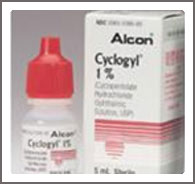
Eye Drops
What are eye conditions seen in children?
Premature infants especially born below 32 weeks age of gestation and weighing less than 1,500 grams are at risk for Retinopathy of Prematurity (ROP). Congenital cataracts and congenital glaucoma are sometimes seen in newborns. Errors of refraction, amblyopia and strabismus are common conditions seen at school age.
What is Retinopathy of Prematurity (ROP)?
The infant's eye is dilated to allow the eye doctor to view the inner eye with an instrument called indirect ophthalmoscope. Timing of diagnosis is of utmost importance in ROP. If diagnosed early, laser treatment, medication or surgery can help improve the chance of the premature eye to see.
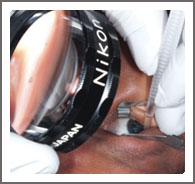
ROP Screening
What is congenital cataract?
A cataract is any opacity or cloudiness in a normally crystal clear lens. Although cataract is usually due to the aging process of the lens, it is not uncommon to see it in newborn infants. Congenital cataracts occur because of an abnormal development in the lens during pregnancy. It can be genetic, metabolic or even a result of an infection during pregnancy. Some congenital cataracts are small and out of the visual axis. These types can be left untouched. However if the congenital cataract obstructs the infant's visual path, it can interfere in the normal development of vision and should be operated as soon as safely possible to allow the vision to develop.

Congenital Cataract
What is congenital glaucoma?
Childhood glaucoma is relatively rare. Congenital glaucoma occurs when there is a malformation in the development of the "drainage system" of the eye. The pressure builds up and damage to the optic nerve occurs. Although difficult, some congenital glaucoma is successfully controlled with surgery and medications. If left untreated, this condition will lead to poor vision and eventually blindness. A child with large, cloudy cornea accompanied by tearing and sensitivity to light should warn the possibility of glaucoma in this child.
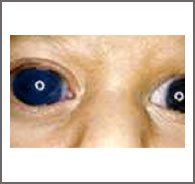
Large cloudy cornea in Congenital glaucoma.
What is amblyopia?
Amblyopia is a decrease in the child's vision even when the structure of the eye is normal. Some people refer to it as "lazy eye" since the amblyopic eye does not function normally and see clearly as the good eye despite the use of glasses or contact lenses. The condition occurs during childhood when one or both eyes send blurred images to the brain. If not treated, the brain only learns to see blurry. Amblyopia can lead to permanent loss of vision.
Are there different types of amblyopia?
There are several types and causes of amblyopia.
- Strabismic amblyopia. This occurs when one eye is not looking straight. The eye may either be in, out, down or up. The brain blocks the vision from the deviated eye. This will then result to poor vision on the deviated eye.
- Deprivation amblyopia. The eye is "deprived" of normal vision because of a cataract, a tumor, a droopy eyelid or a similar condition that obstructs the visual axis of the patient's eye. Since the view is obstructed, that eye will not develop normal vision.
- Refractive amblyopia. An imbalance in the amount of refractive error (nearsightedness, farsightedness and/or astigmatism) will cause the brain to favor the eye with a lower refraction. The eye with a higher error will result to a poorer vision.
Is there treatment for amblyopia?
Yes if amblyopia is caught early. Improvement is still seen even if treatment was started as late as 14 years of age but better treatment success may be achieved if treatment is started early (less than 7-10 years old).
Removing the obstruction in deprivation type of amblyopia will help improve the vision. Glasses with or without patching the good eye also correct amblyopia in the strabismic and refractive type. Patching the good eye forces the lazy eye to work more. An improvement in vision is normally seen within weeks after initiation of patching.
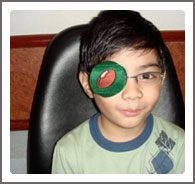
Child wearing an eye patch over his glasses
When should a child wear eyeglasses?
There are several indications for which a child needs glasses. Eyeglasses can provide clearer or better vision that would help him with his tasks. It can help a child straighten his eyes when they are crossed in or deviated out. It can strengthen the weak or lazy eye.
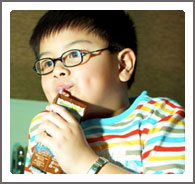
Child wearing eyeglasses
How do you test if the child needs glasses?
Errors of refraction such as near sightedness (myopia), far sightedness (hyperopia) or astigmatism are also common in children. Like in adults a refractive error would also give the child a blurred image. In kids this can be measured accurately by dilating the pupil with an eye drop that relaxes the focusing muscle of the eye. The eye doctor then uses a device, called a retinoscope, that reflexes light into the dilated eye. With this instrument the doctor is able to arrive at the proper measurement.
Although automated refractors or the computer-controlled machines that measure the refractive error are easy to use in children, it will not be accurate because children have a strong focusing mechanism. In fact,even if the child is fully cooperative, the use of a dilating drop that relaxes the focus of the lens is still recommended before deciding if the child needs glasses or not. Some degree of refractive error in children may not need glasses and can only be monitored over time.
What is strabismus?
Strabismus is a condition in which the eyeballs are not aligned and point towards different directions. One eye may look straight while the other eye deviates inward (esotropia), outward (exotropia), upward (hypertropia) or downward (hypotropia). The straight eye may also turn in while the deviated eye can look straight. It may be constant or it may come and go. Children are often born with the condition but strabismus can also be acquired later in life.

Eye is deviated out in Exotropia and crossed eye in Esotropia
Adults can acquire strabismus due to trauma or accidents and due to medical conditions such as thyroid disease, myasthenia gravis, diabetes, tumors and stroke.
Strabismus should be differentiated from pseudostrabismus. A young child with a wide, flat nose bridge would appear crossed eye even if his eyes are straight. This false impression of strabismus is called pseudostrabismus.
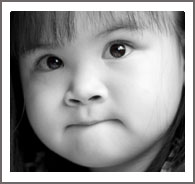
Eyes appear crossed with a flat and broad nose bridge in Pseudostrabismus.
What are the symptoms of strabismus?
One would notice that the eyes are not aligned although sometimes, misalignments are not obvious. Adults may complain of double vision (diplopia) or experience tightness or a "pulling sensation" when moving the eye. Loss of depth perception such as bumping into things or tripping in the steps can be noticed in both adults and children alike. Children with an abnormal head position like tilting or turning in one direction should be evaluated for strabismus.
How is strabismus treated?
In some cases, eyeglasses can be prescribed to straighten eyes. Other treatments may involve eye muscle surgery, prism glasses and Botox injections.
It is never too late to treat strabismus. Children and adults do not need to live with the discomfort and problems caused by misaligned eyes. With the ophthalmologist's help, surgery or a combination of other treatment methods can improve the symptoms associated with strabismus.
Strabismus surgery or Eye muscle surgery is the most common treatment for strabismus. Typically, strabismus occurs when the muscles surrounding the eyes are either too strong/stiff or too weak. An ophthalmologist can surgically loosen the strong /stiff muscle or tighten the weak muscle so that the eyes can be rebalanced to work together.
Strabismus surgery is usually performed on an outpatient basis using general or local anesthesia. In adults, adjustable suture technique may be offered. To obtain more precise alignment, this technique allows eye adjustment when the patient is fully awake. Using eye-drop anesthesia, the sutures are tied and untied to "fine-tune" the alignment.
Prism eyeglasses can correct mild double vision associated with adult strabismus. A prism is a clear wedge-shaped lens that displaces the image on the deviated eye to realign with the straight eye. The prisms can be worn on the outside of the eyeglass frame like a sticker or it can be manufactured directly into the lens itself.
Botox injections. If an "over-reactive" eye muscle is the cause of strabismus, Botox injection can stabilize the muscle and relieve the symptoms of strabismus. Botox is a drug that when injected in small amounts temporarily paralyzes or weaken muscles. When injected into the eye muscle, the effects can last several months and may even result in a permanent change in eye alignment.



